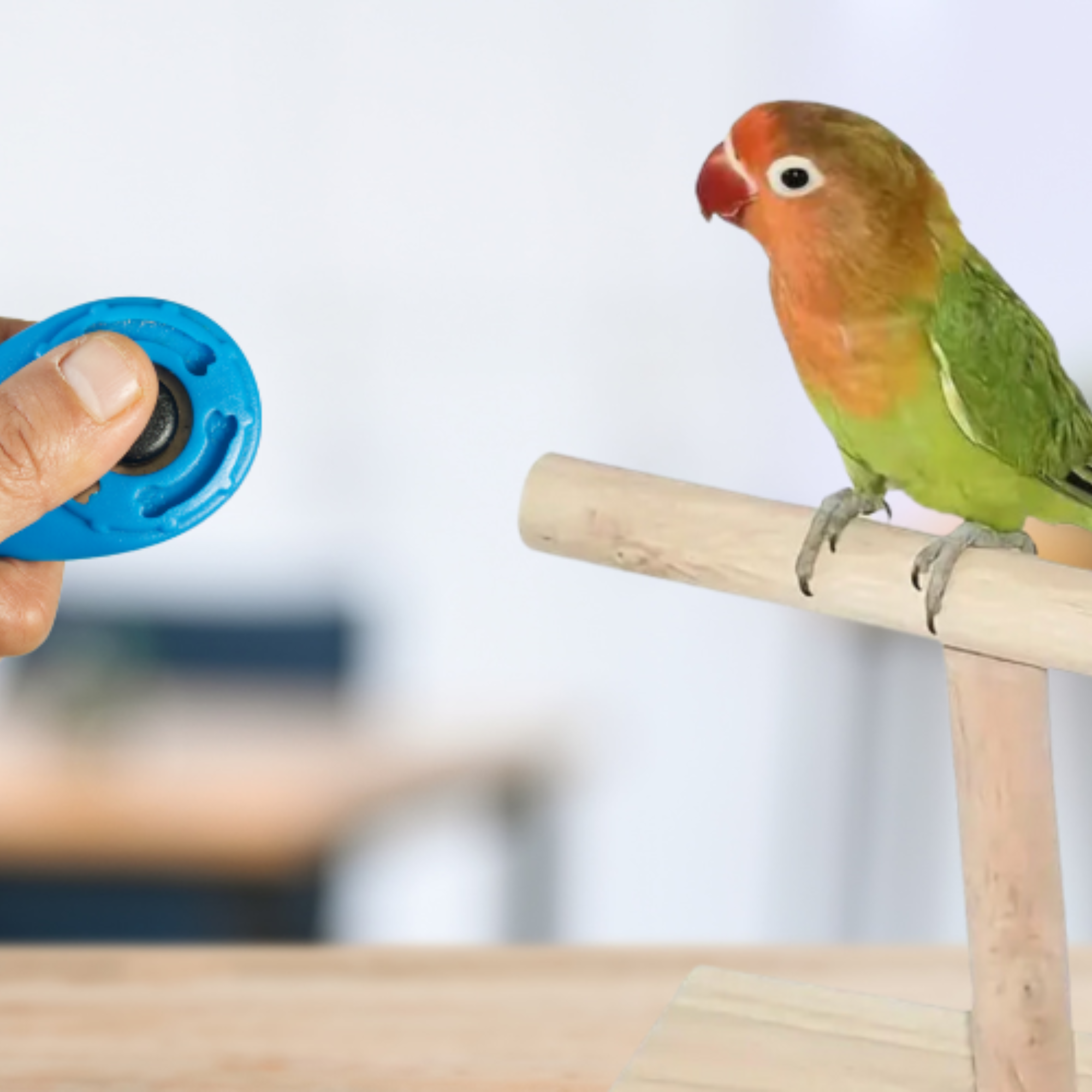Revised June 16, 2024
Table of Contents
- Clicker Training Basics
- 1. It's a positive way for better bird behavior!
- 2. Clicker training creates a bonding experience for a calmer bird.
- 3. Clicker training helps you teach replacement behaviors.
- 4. Clicker training stimulates your smart bird’s intellect.
- 5. Clicker training makes you a positive reinforcement expert
- 6. You learn to read bird body language for better communication with your pet.
It's famous for training dogs, but did you know clicker training works wonders for birds too?
Clicker training is based on a method called Operant Conditioning, which was developed by a famous Harvard psychologist named B.F. Skinner. Skinner's experiments, often using pigeons, showed how animals can learn complicated tasks by being rewarded for good behavior. Since then, many studies have shown that clicker training works well with all kinds of animals, including birds.
It works because you're teaching your bird what to do, rather than what not to do. With no punishment or force involved, your bird will love the training sessions. It's so simple that you can learn it in no time!
Positive training is one of the best ways to show your bird that you love it.
6 Exciting Benefits of Clicker Training for Birds in 2024

1. It's a positive way for better bird behavior!
Clicker training uses a small device that makes a "click" sound to teach your bird new behaviors. When your bird does something you want, you click and then give it a treat. This way, your bird learns that good behavior gets rewarded.
Your bird will enjoy learning new things because it gets a reward each time. If you use clicker training correctly, it can be a very effective way to train your bird.
Clicker Training Basics:
- All you need is a clicker.
- Decide which behaviors you want to encourage and discourage.
- A cue is a signal you give your bird to perform a desired behavior.
- Quickly reinforce the correct response with a treat.
- Discover the best treats for your bird.
2. Clicker training creates a bonding experience for a calmer bird.
Clicker training helps you and your bird understand each other better. The click sound and treats create a special way to talk to your bird. When your bird does something good, you click and give it a treat. This makes your bird happy and eager to learn more.
The more you click and treat, the stronger your bond becomes. Your bird will love doing the new trick because it knows it will get a treat. Over time, you can use a cue to ask your bird to do the trick whenever you want. This makes training fun and helps you and your bird get closer.
3. Clicker training helps you teach replacement behaviors.
One of the best ways to curb unwanted behavior is to teach a fun alternative that serves the same purpose. If your bird screams for attention, shower it with love when it whistles at you or plays with a toy. You can do it!
If your bird has been indulging in aggressive behaviors, you can easily curb them with clicker training. By rewarding healthy, safe actions, you'll make it more likely for your bird to repeat the new, positive behavior. And when you stop reinforcing the unwanted behavior, it loses its purpose.
With clicker training, you can teach your bird new, safe behaviors to replace the ones you don’t like. First, give your bird a signal, or "cue," for the new behavior. When your bird follows the cue, reward it with a treat. This way, when your bird starts doing something undesirable, you can signal the new behavior and reward it when it listens. You’ve got this!
4. Clicker training stimulates your smart bird’s intellect.
Birds are incredibly smart, which is why famous psychologist B.F. Skinner often used them in his experiments. Clicker training keeps your bird’s brain active by helping it connect new cues with actions. With clicker training, you can teach your bird a variety of tricks, from simple actions to complex sequences.
This training not only boosts your bird’s confidence but also keeps it mentally stimulated and happy. Learning new tricks keeps your bird busy and improves its mood. If your bird feels anxious, doing a trick can help calm it down by focusing on something fun and positive.
5. Clicker training makes you a positive reinforcement expert
Did your bird just do something you’d love to see more often?
With clicker training, you can ensure your bird repeats good behaviors by quickly rewarding it with a cue and a motivating treat for the new action. As your bird gets better, you can slowly fade the cue while focusing on adjusting the new behavior. The more your bird engages in behaviors you love, the deeper your bond becomes and the more confident it feels.
So, all you need to do is intentionally reward the behaviors you want to see more of. That's called "positive reinforcement."
6. You learn to read bird body language for better communication with your pet.
Communicating with our feathered friends can be challenging because we don't always understand their chirps, squawks, or body language. And they might not always get what we're trying to say either.
But with clicker training, we can bridge this gap. Clicker training helps you teach your bird what specific keywords mean. For example, your bird will learn exactly what you mean when you say, "Go potty," or "Come here."
More importantly, it also helps you learn to watch your bird's body language more closely. By paying attention to their cues, you can better understand their needs and responses, making your communication even more effective and your bond stronger.
Yes! You can (and should) teach your bird manners!
All in All
Clicker training is an amazing way to communicate with your feathered friend using positive reinforcement. It helps reduce unwanted behavior and increases the likelihood of good behaviors and creates an everlasting bond between the two of you. it is one of the best ways to bond with your bird.
______FAQ: Clicker Training for Birds
Clicker training is a method of teaching animals using a small device that makes a "click" sound. This sound marks the desired behavior, and is immediately followed by a treat as a reward. This method helps animals understand which behaviors are being rewarded.
Clicker training works for birds by associating the click sound with a specific behavior and a reward. When your bird performs a desired action, you click the device and then give a treat. Over time, your bird learns to repeat the behavior to get the reward.
To start clicker training your bird, you'll need:
- A clicker device
- Treats that your bird loves
- Patience and consistency
Positive reinforcement is important because it encourages your bird to repeat good behaviors by rewarding them. This method builds trust and strengthens the bond between you and your bird without using punishment or force.
Choose small, tasty treats that your bird loves. They should be easy to eat quickly so your bird can focus on the training session. For more information, check out our guide on discovering the best treats for your bird.
Clicker training can improve your bird's behavior by teaching it new, desired actions to replace unwanted behaviors. By consistently rewarding good behaviors, you can reduce aggression, screaming, and other issues.
Yes, clicker training can help with bird anxiety by providing mental stimulation and a positive focus. Training sessions can calm your bird by giving it something fun and rewarding to concentrate on.
To introduce a new cue, start by giving the cue just before your bird performs the desired behavior. Click and reward your bird when it responds correctly. Repeat this process consistently until your bird associates the cue with the action.
Short, frequent training sessions work best. Aim for a few minutes, a few times a day. This keeps your bird engaged without overwhelming it.
If your bird doesn't respond to the clicker, try using a different type of treat or adjusting the timing of the click and reward. Be patient and consistent, and ensure your bird is in a calm environment during training sessions.
Yes, most birds can be clicker trained, regardless of their species. The key is to be patient, consistent, and use positive reinforcement to encourage the desired behaviors.
Related Posts:
Your all-in-one clicker training for birds guide
Choosing Bird Training Supplies
Diane Burroughs, LCSW is a licensed psychotherapist trained in ABA therapy techniques. She specializes in avian anxiety disorders and is certified in Nutrition For Mental Health. Diane has written a number of bird behavior books and she offers behavior consultations. She's developed a range of UnRuffledRx Science-backed Parrot Wellness Supplies.
Diane's products have been featured in the Journal of Avian Medicine and Surgery and at Exoticscon, a conference for exotic pet veterinarians. Her bird collars & supplements are stocked in avian vet clinics and bird stores throughout the US. With over 30 years in the field of behavior, Diane has created thousands of successful individualized behavior plans that help pets thrive.
TAGS: #ClickerTrainingForBirds #BirdClickerTraining
SHARING IS CARING! PLEASE SHARE ON YOUR FAVORITE SOCIAL MEDIA NOW!





